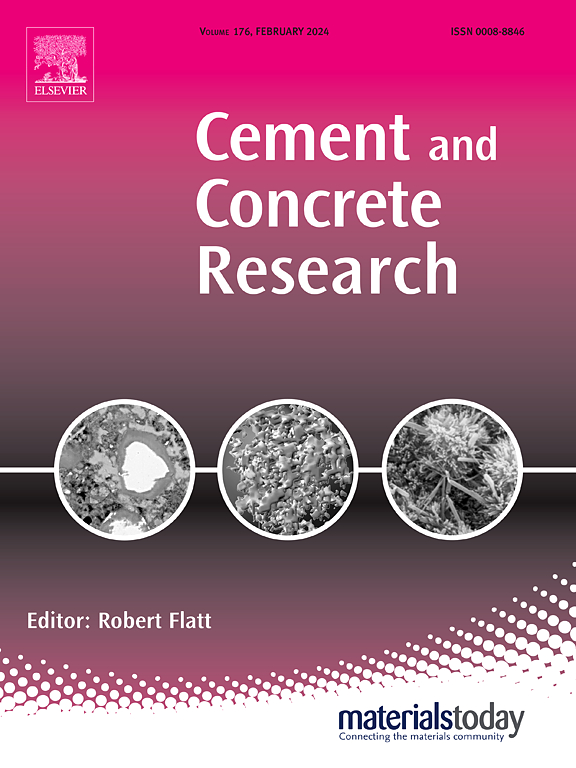研究OTES@silica纳米胶囊对水泥浆体抗水性能和抗压强度的影响及其机理
IF 13.1
1区 工程技术
Q1 CONSTRUCTION & BUILDING TECHNOLOGY
引用次数: 0
摘要
疏水剂对胶凝材料进行体积改性是降低胶凝材料吸水率的有效策略。然而,抗压强度的降低一直是最显著的问题之一。本文报道了以正辛基三乙氧基硅烷(OTES)为核心材料和硅壳的缓释胶囊(OTES@SC)的合成。胶囊(含70.0%的OTES)使OTES在数天内连续释放。OTES@SC的加入降低了水泥浆体的吸水率,提高了水泥浆体的抗压强度。在较高的胶囊剂量下,这两种效果都更为明显(在0.5 wt%的胶囊剂量下,吸水率降低~ 70.6%,抗压强度增加17.4%)。OTES@SC中OTES的持续释放,使得水泥浆体和新形成的OTES都能进行持续的表面改性。与直接加入OTES相比(水化过程中疏水层的平均厚度从~10 nm减小到~0 nm),疏水层在28 d时达到了几个分子层的厚度,水泥浆体颗粒表面的均匀性显著提高。由于层数较薄以及熟料部分活性部位正常水化,OTES对水化的抑制作用大大降低。此外,火山灰效应和二氧化硅的纳米尺寸进一步促进了水化作用。从而OTES@SC提高了膏体的水化程度,细化了膏体的孔隙结构。本文章由计算机程序翻译,如有差异,请以英文原文为准。
Elucidating the effects and mechanisms of OTES@silica nano capsules on water resistance and compressive strength of cement paste
The bulk modification of cementitious materials by hydrophobic agents is an effective strategy to reduce the water absorption. However, the decrease in compressive strength has been one of the most significant problems. We reported in this paper the synthesis of a sustained-release capsule (OTES@SC) with n-octyltriethoxy silane (OTES) as core material and silica shell. The capsule (containing 70.0 % of OTES) enabled the continuous release of OTES within days. The addition of OTES@SC reduced the water absorption while improved the compressive strength of hardened cement paste. Both the effects would be more pronounced at higher capsule dosages (~70.6 % water absorption reducing and 17.4 % increase of compressive strength at 0.5 wt% capsule dosage). The sustained release of OTES from OTES@SC enabled the continuous surface modification by OTES both already in cement paste and newly formed. Compared with the direct addition of OTES (average thickness of the hydrophobic layer decreased from ~10 nm to ~0 nm during hydration), the hydrophobic layer had reached a thickness of a few molecules layer at 28 d, exhibiting significantly improved uniformity on cement paste particle surfaces. The thinner layer and the normal hydration of part of reactive sites of clinkers greatly reduced the inhibition effect of OTES on hydration. Additionally, the pozzolanic effect and nano-size of silica further promoted hydration. Thus, OTES@SC improved hydration degree and refined pore structure of paste.
求助全文
通过发布文献求助,成功后即可免费获取论文全文。
去求助
来源期刊

Cement and Concrete Research
工程技术-材料科学:综合
CiteScore
20.90
自引率
12.30%
发文量
318
审稿时长
53 days
期刊介绍:
Cement and Concrete Research is dedicated to publishing top-notch research on the materials science and engineering of cement, cement composites, mortars, concrete, and related materials incorporating cement or other mineral binders. The journal prioritizes reporting significant findings in research on the properties and performance of cementitious materials. It also covers novel experimental techniques, the latest analytical and modeling methods, examination and diagnosis of actual cement and concrete structures, and the exploration of potential improvements in materials.
 求助内容:
求助内容: 应助结果提醒方式:
应助结果提醒方式:


